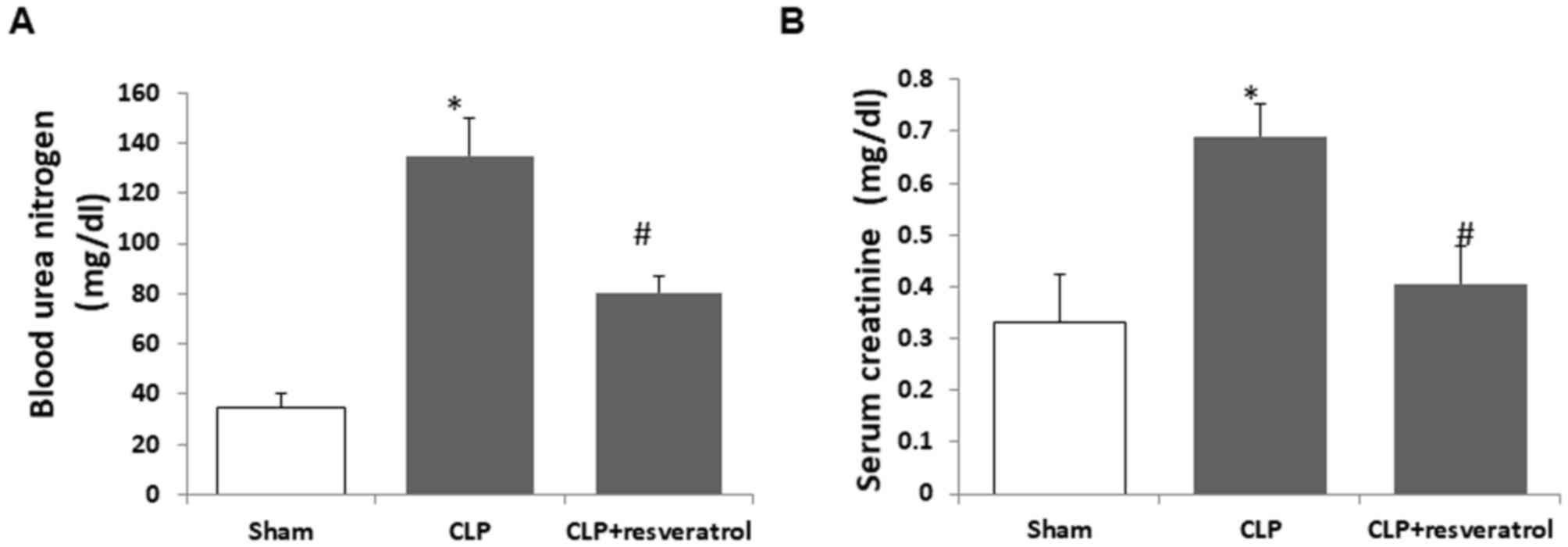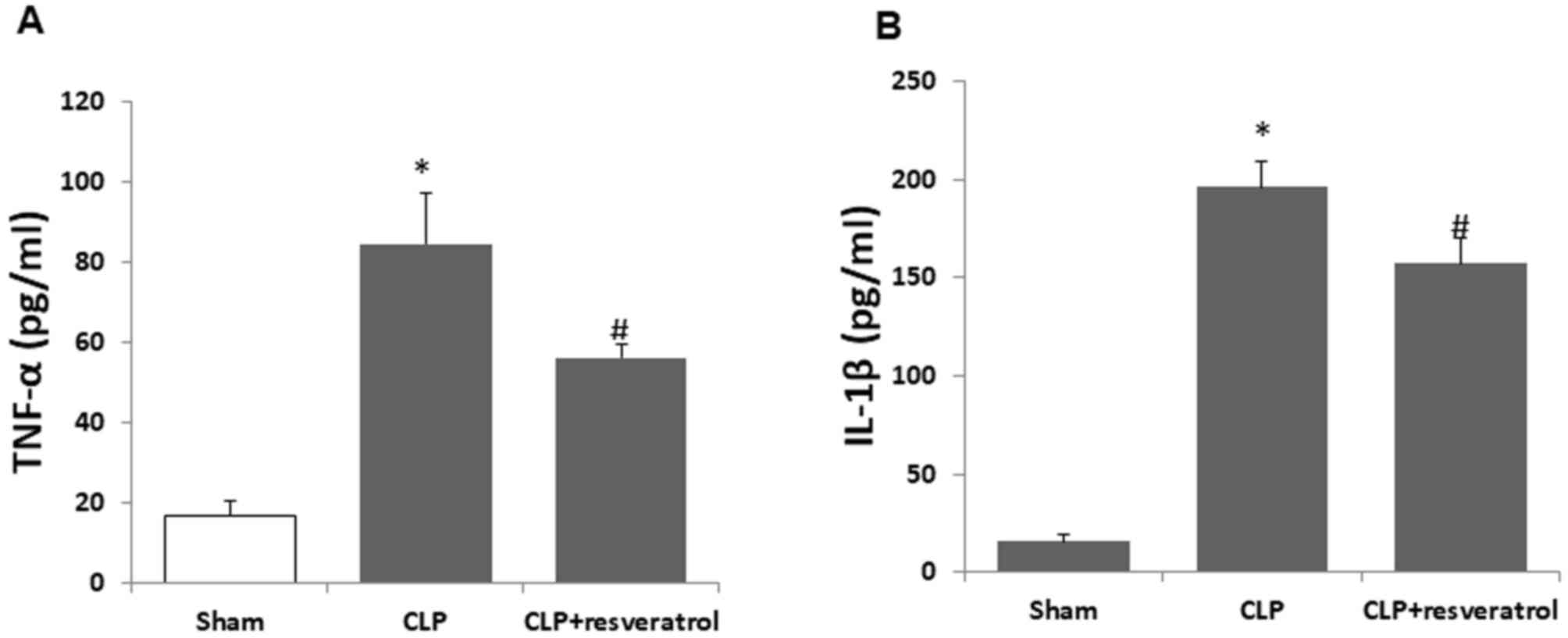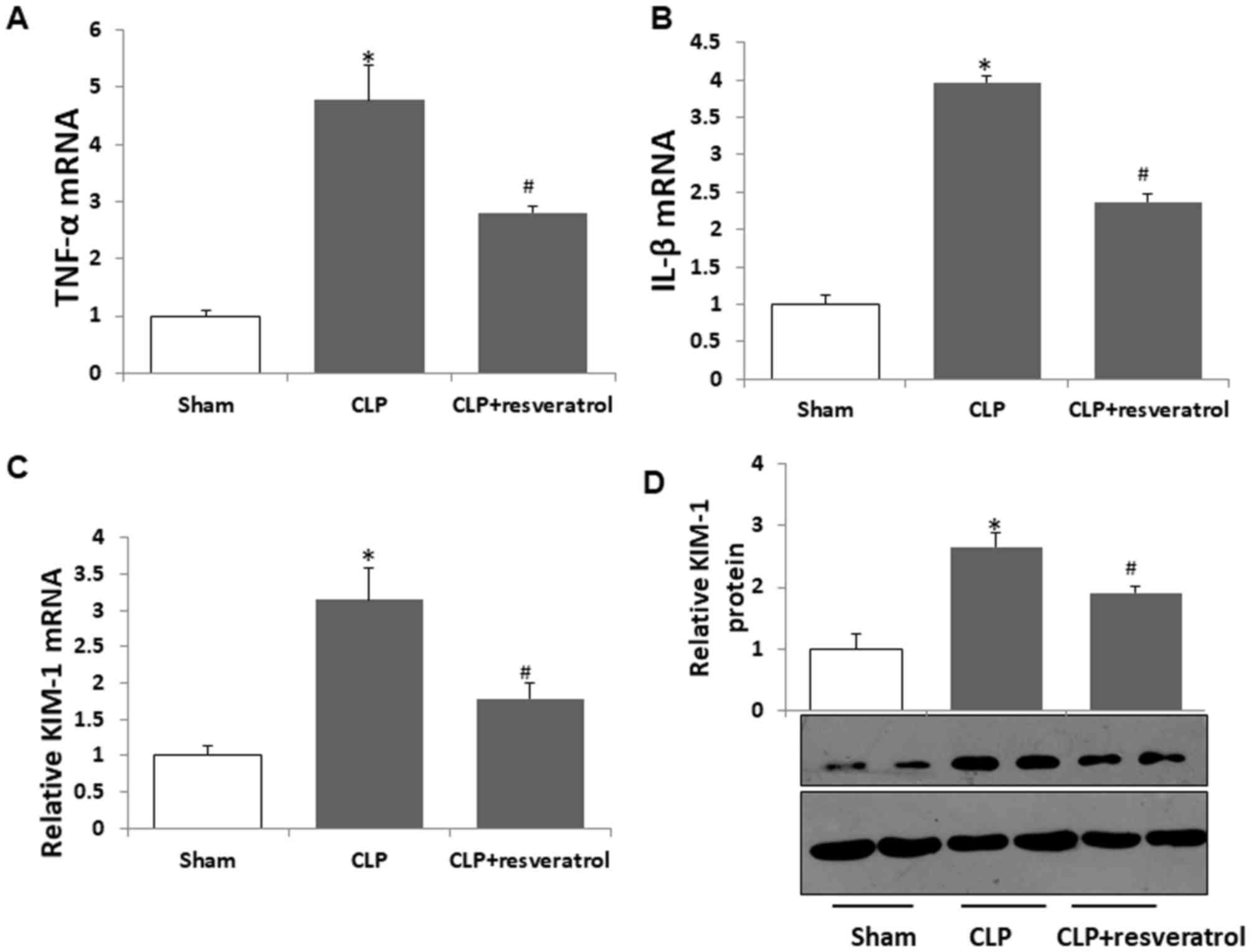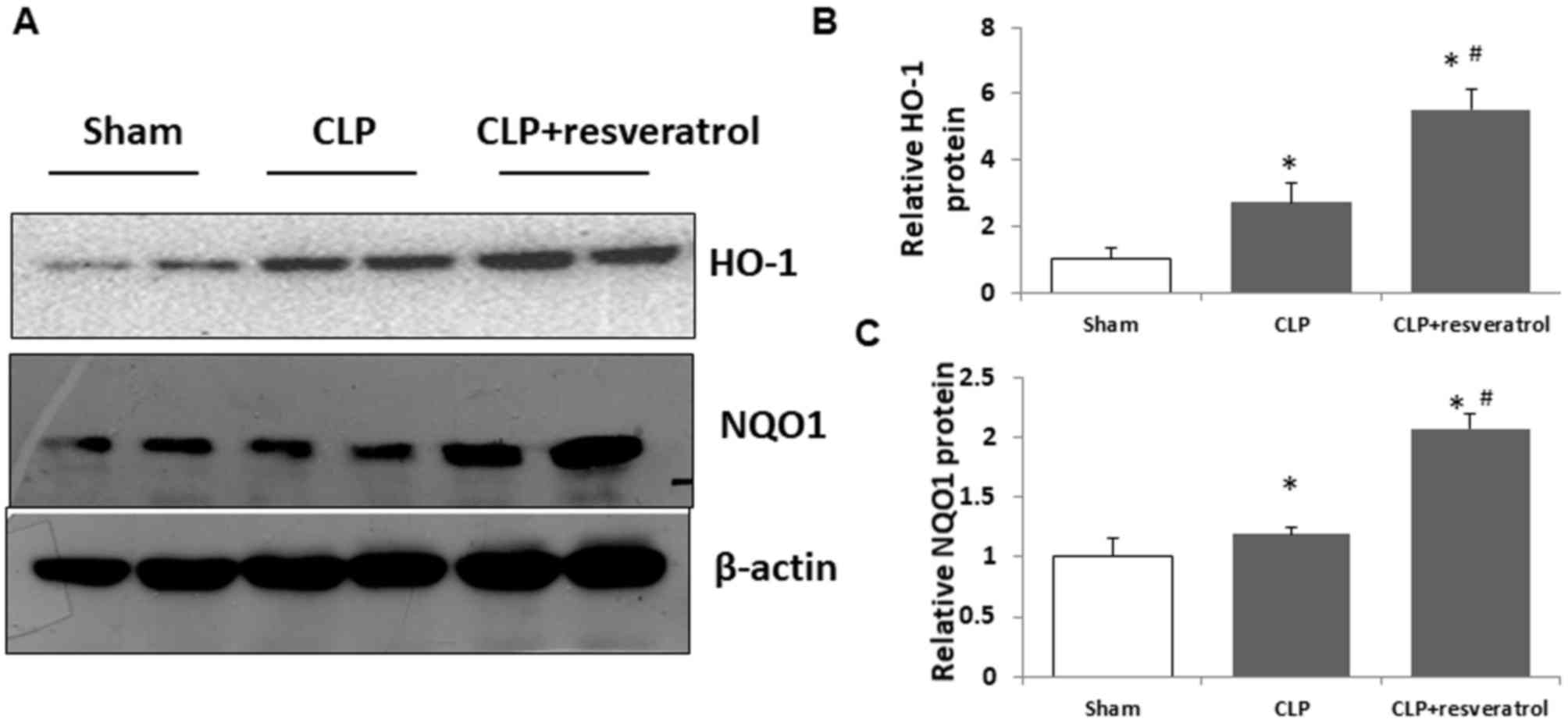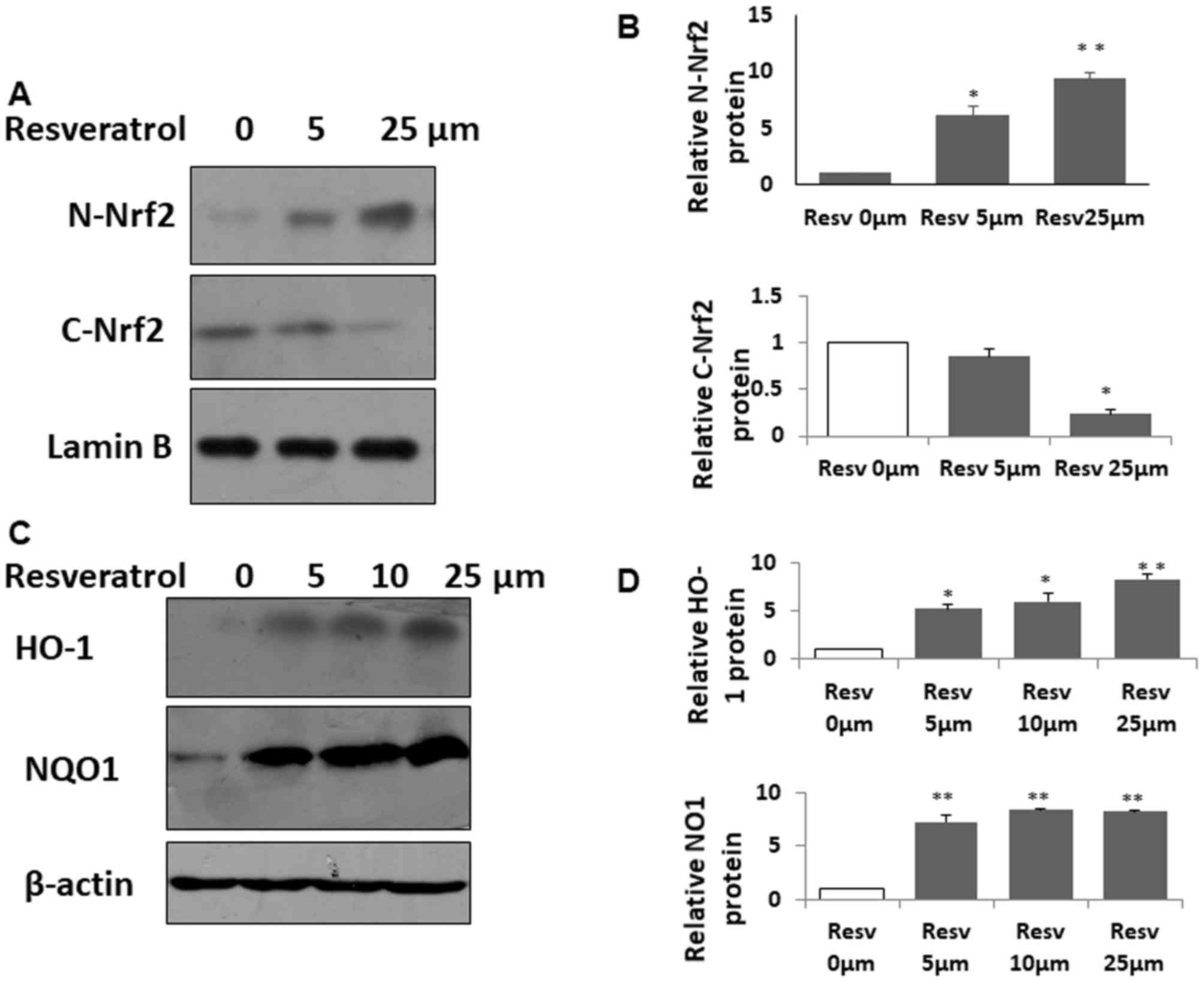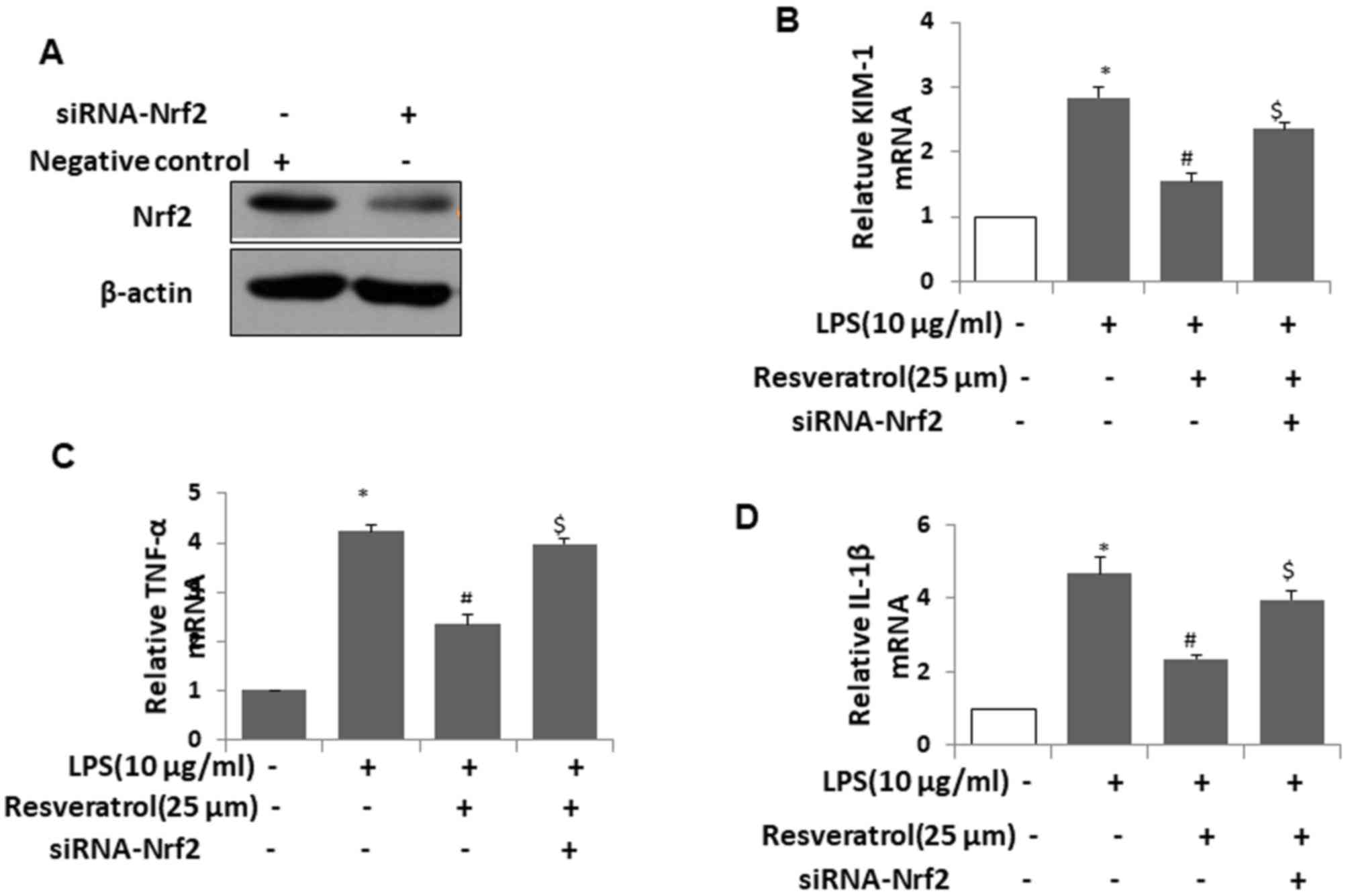Introduction
Sepsis is a condition characterized by a whole-body
inflammatory response caused by a harmful host response to
infection and is a leading cause of death in children (1). Sepsis is also the second leading cause
of acute kidney injury (AKI) in children. AKI is a serious
condition defined by the rapid dysfunction of the kidneys within
several hours to weeks and has been a serious problem in the
pediatric intensive care unit (2).
It is worth noting that in the pediatric population, the presence
of AKI is associated with an increased mortality compared with that
of sepsis alone (3,4). Studies have demonstrated that those
patients who survive AKI have a higher risk of future development
of chronic kidney diseases (5).
However, current therapies for sepsis-induced AKI in pediatric
patients are mostly supportive (6).
Therefore, it is critical to discover novel and effective
therapeutic methods for promoting kidney repair after AKI. Most
research on sepsis-induced AKI has utilized adult rodent models;
however, the developing kidney in children is more susceptible to
oxidative stress (7). The present
study used the rat pup cecal ligation and puncture (CLP) model,
which displays numerous characteristics of sepsis-induced AKI in
pediatric patients with sepsis and has been verified to be suitable
for exploring possible therapies (8).
Resveratrol (3,5,4′-trihydroxy-trans-stilbene) is a
polyphenolic phytoalexin and is distributed in several food plants
such as grapes, berries and peanuts (9,10).
Previous studies have revealed that resveratrol exerts protective
effects in various disease models, including those of several types
of renal injury, via its anti-oxidant and anti-inflammatory
properties (11–14). It has been reported that the
para-hydroxy group of resveratrol has the ability to scavenge free
radicals (15), thus rendering
resveratrol with an intrinsic anti-oxidant capacity.
Nuclear factor-erythroid-2-related factor 2 (Nrf2)
is encoded by the NFE2L2 gene and is a basic leucine zipper
transcription factor. Under resting conditions, Nrf2 is held in the
cytoplasm by its repressor kelch-like ECH-associated protein 1
(Keap1) and removes it through ubiquitination-proteasomal
degradation. When cells are exposed to oxidative stress or noxious
attacks, Nrf2 dissociates from Keap1 and translates to the nucleus,
where it binds to the anti-oxidant response element (ARE) within
the promoter of its downstream genes, including uridine
5′-diphospho-glucuronosyltransferase, NAD(P)H:quinone
oxidoreductase-1 (NQO1), heme oxygenase-1 (HO-1), glutathione
S-transferase, glutamate cysteine ligase and glutathione peroxidase
(16). Most of these genes are
important anti-oxidant enzymes and cytoprotective genes. It has
been reported that Nrf2-mediated transcriptional responses have an
important protective role in ischemic and nephrotoxic acute kidney
injury (17). Resveratrol also has
protective effects by triggering the Nrf2 signaling pathway
(18–20). However, the protective role of Nrf2
in sepsis-induced pediatric AKI has remained elusive.
Above all, this evidence led to the hypothesis that
resveratrol may alleviate sepsis-induced AKI in a pediatric rat
model and induce the activation of Nrf2 signaling pathway, which
was tested in the present study. The results revealed that
downregulation of tumor necrosis factor (TNF)-α, interleukin
(IL)-1β and kidney injury molecule (KIM)-1 expression induced by
resveratrol was abrogated in the absence of Nrf2.
Materials and methods
Cell culture and transfection
HK2 cells (obtained from the American Type Culture
Collection, Manassas, VA, USA) were maintained in Dulbecco's
modified Eagle's medium/F12 (Gibco; Thermo Fisher Scientific, Inc.,
Waltham, MA, USA) supplemented with 10% fetal bovine serum (Gibco;
Thermo Fisher Scientific, Inc.). Cells were cultured in an
incubator with a humidified atmosphere of 5% CO2 in air
at 37°C. Small interfering RNA (siRNA) targeting Nrf2 (siRNA-Nrf2;
cat. no. sc-44332) was purchased from Santa Cruz Biotechnology,
Inc. (Dallas, TX, USA). An unspecific siRNA with random nucleotides
(purchased from Guangzhou RiboBio Co., Ltd., Guangzhou, China) was
used as the negative control. Transfection was performed using the
Lipofectamine 2000 reagent (Invitrogen; Thermo Fisher Scientific,
Inc.).
CLP model
Animal maintenance and experiments were performed in
accordance with the guidelines for the care and use of experimental
animals of the US National Institutes of Health (Bethesda, MD,
USA), and were approved by the Animal Care Committee of Xi'an
Children's Hospital (Xi'an, China).
CLP was performed on six male Sprague Dawley rat
pups (weight, 40–60 g; purchased from Model Animal Research center
Of Nanjing University) aged 17–18 days as described previously
(21). All rats were housed under
standard conditions (temperature 20–25°C; humidity 50%), received a
normal diet and sterile water ad libitum and were exposed to
a 12 h light/dark cycle. The rat pups were anesthetized with 2.5%
isoflurane (Sigma-Aldrich; Merck KGaA, Darmstadt, Germany) and
placed on a warm pad. Following laparotomy, 1.5 cm of the cecal tip
was ligated using 4-0 silk and punctured twice with an 18-gauge
needle. Approximately 1 mm of fecal material was expressed from the
punctures. In sham-operated pups, the cecum was isolated but
neither ligated nor punctured. Following surgery, all rats received
1 ml warm saline via intraperitoneal injection and were placed in
individual cages on a heating pad. Rats assessed for durations of
>6 h were administered intraperitoneal imipenem/cilastatin (14
mg/kg; Sigma-Aldrich; Merck KGaA) and intraperitoneal warm saline
(38 ml/kg) at 6 h after surgery.
Administration of resveratrol
Fresh resveratrol (Sigma-Aldrich; Merck KGaA) was
dissolved in dimethyl sulfoxide and kept in the dark. The CLP rats
were intraperitoneally injected with diluted resveratrol (30 mg/kg)
at 6 h after surgery and then again at 12 h. At 18 h after CLP, the
experimental rats were euthanized. Blood and kidneys were acquired
and stored at −80°C for further analysis.
To mimic the AKI in vitro, following the
transfection of siRNA, HK2 cells were treated with 10 µg/ml LPS
(Sigma-Aldrich; Merck KGaA) for 12 h at 37°C, Resveratrol was also
administered at the time point.
Plasma electrolyte analysis
Serum creatinine and blood urea nitrogen levels were
measured using the QuantiChrom Creatinine/Urea Assay kit (cat. no.
DICT-500/DIUR-100; BioAssay Systems, Hayward, CA, USA). Serum IL-1β
and TNF-α levels were measured using a MILLIPLEX MAP kit (cat. no.
EZRTNFA; EMD Millipore, Billerica, MA, USA).
Reverse transcription-quantitative
polymerase chain reaction (RT-qPCR) analysis
Total RNA was isolated from whole kidneys using
TRIzol reagent (Invitrogen; Thermo Fisher Scientific, Inc.)
according to the manufacturer's instructions. Subsequently, 1 µg
RNA was converted into complementary (c)DNA using the Transcript
first-strand cDNA synthesis kit (cat. no. R111-01/02, Vazyme,
Nanjing, China). PCR was performed using SYBR Green PCR Master Mix
(Vazyme) and the following primers: GADPH forward,
5′-CCCTCAAGATTGTCAGCAATG and reverse, GTCCTCAGTGTAGCCCAGGAT-3′;
IL-1β forward, 5′-CACCTTCTTTTCCTTCATCTTG-3′ and reverse,
5′-GTCGTTGCTTGTCTCTCCTTGTA-3′; TNF-α forward,
5′-CATGATCCGAGATGTGGAACT-3′ and reverse,
5′-TCACAGAGCAATGACTCCAAA-3′; KIM-1 forward,
5′-ATGAATCAGATTCAAGTCTTC-3′ and reverse,
5′-TCTGGTTTGTGAGTCCATGTG-3′. The thermocycling conditions were as
follows: 95°C for 5 min; 40 cycles at 95°C for 10 sec, followed by
60°C for 30 sec; and 95°C for 15 sec, followed by 60°C for 60 sec
and 95°C for 15 sec. Analysis of the real-time qPCR data to
determine relative gene expression was performed using the
2−ΔΔCq method (22).
Western blot analysis
Nuclear and cytosolic proteins were isolated using a
Nuclear Extraction kit (cat. no. P0027; Beyotime Institute of
Biotechnology, Inc., Haimen, China) and the total proteins were
acquired from the kidney tissues or cells using cell lysis buffer
RIPA (cat. no. P0013B; Beyotime Institute of Biotechnology, Inc.).
Protein was quantified using an enhanced BCA protein Assay kit
(cat. no. P0009; Beyotime Institute of Biotechnology, Inc.).
Proteins (2 µg) were separated by 10% SDS-PAGE and then transferred
onto a polyvinylidene difluoride membrane (EMD Millipore).
Membranes were then blocked at room temperature using 5% skimmed
milk for 1 h. The following antibodies were used to detect the
protein levels: KIM-1 (1:200; cat. no. PA1632; Boster Biological
Technology, Wuhan, China), Nrf2 (1:1,000; cat. no. Sc-722; Santa
Cruz Biotechnology, Inc.), HO-1 (1:1,000; cat. no. OSA-150C;
StressGen, Biotechnologies Corp., Victoria, BC, Canada), NQO1
(1:1,000; cat. no. NB200-209; Novus Biologicals, LLC, Littleton,
CO, USA), β-actin (1:5,000; cat. no. BM0627; Boster Biological
Technology), LaminB (1:500; cat. no. sc-6216; Santa Cruz
Biotechnology, Inc.), goat anti-rabbit immunoglobulin G
(IgG)-horseradish peroxidase (HRP; 1:5,000; cat. no. SN134;
Sunshine Bio, Changsha, China) and goat anti-mouse IgG-HRP antibody
(1:5,000; cat. no. SN133; Sunshine Bio). Primary antibodies were
incubated at 4°C overnight, while secondary antibodies were kept at
room temperature for 2 h. Results were visualized using an ECL kit
(cat. no. E412-01/02; Vazyme, Piscataway, NJ, USA).
Statistical analysis
Values are expressed as the mean ± standard
deviation. Differences between multiple groups were analyzed using
one-way analysis of variance, followed by a post-hoc
Student-Newman-Keuls test. P<0.05 was considered to indicate a
statistically significant difference, SPSS 17.0 software (SPSS,
Inc., Chicago, IL, USA) was used to analyze data.
Results
Resveratrol attenuates the decline of
renal function induced by CLP
The goal of the present study was to investigate
whether resveratrol protects rat pups from renal dysfunction
induced by sepsis. A rat pup model of CLP was used to mimic
sepsis-induced AKI in children. At the onset of the study, all rat
pups were divided into 3 groups (n=6). In the treatment group, rat
pups received two injections of resveratrol after CLP surgery.
Serum creatinine and blood urea nitrogen levels are
two important measures of kidney function (23). At 18 h after CLP surgery, serum from
the pups in each group was collected for analysis. In CLP model
mice, blood urea nitrogen (Fig. 1A)
and serum creatinine (Fig. 1B) were
significantly elevated compared with those in the sham group.
However, resveratrol treatment markedly attenuated the upregulation
of urea nitrogen (Fig. 1A) and serum
creatinine (Fig. 1B) induced by CLP.
These results indicated that resveratrol alleviated the decline of
renal function induced by CLP in rat pups.
Resveratrol ameliorates CLP-induced
inflammatory response and increase of KIM-1
Sepsis is a disseminated inflammatory response and
the systemic inflammatory response following CLP is associated with
early release of cytokines such as TNF-α and IL-1β (24). CLP not only produces a systemic
inflammatory response but also induces inflammation in the kidney.
To further verify the effect of resveratrol on sepsis-induced AKI,
the levels of TNF-α and IL-1β in serum and kidney tissue were
measured in the present study. In the serum, resveratrol
significantly inhibited the increase of TNF-α (Fig. 2A) and IL-1β (Fig. 2B) induced by CLP. Similar results
were obtained in kidney tissues (Fig. 3A
and B).
Kidney injury molecule, a transmembrane type 1
glycoprotein, is a well-characterized biomarker in experimental
animals and humans with renal disease (25). The results revealed that KIM-1 mRNA
in kidneys was markedly increased after CLP, which was inhibited by
resveratrol (Fig. 3C). Resveratrol
also attenuated the increase of KIM-1 protein induced by CLP
(Fig. 3D).
These results indicated that resveratrol ameliorated
CLP-induced AKI in rat pups.
Resveratrol enhances Nrf2 target gene
expression in the kidneys
To test whether resveratrol induces Nrf2 function in
kidneys during CLP-induced AKI, the Nrf2 target genes HO-1 and NQO1
were evaluated. HO-1 and NQO1 proteins were further increased by
resveratrol (Fig. 4A-C). These
results indicated that the protective effect of resveratrol on
sepsis-induced AKI in a rat pup model was probably due to the
activation of Nrf2.
Resveratrol activates the Nrf2 pathway
in vitro
To further verify the effect of resveratrol in Nrf2,
HK2 cells were treated with different doses of resveratrol for 3 h.
Nrf2 nuclear translocation is a necessary step for Nrf2 activation;
therefore, nuclear protein was isolated and assessed for the amount
of Nrf2. The results indicated that resveratrol induced the
accumulation of Nrf2 in the nucleus (Fig. 5A and B). In this in vitro
experiment using HK2 cells, it was also verified that resveratrol
increased the expression of HO-1 and NQO1 in a dose-dependent
manner (Fig. 5C and D). Taken
together, these results illustrated that resveratrol indeed
activated the Nrf2 pathway in HK2 cells.
Knockdown of Nrf2 effectively
abrogates the protective effect of resveratrol in vitro
To verify the role of the Nrf2 signaling pathway in
the protection of resveratrol, HK2 cells were treated with
lipopolysaccharide (LPS) to mimic AKI in vitro. Cells were
transfected with siRNA-Nrf2 for 12 h to knockdown the expression of
Nrf2 prior to LPS treatment. Western blot analysis was used to
confirm effective knockdown of Nrf2 by siRNA-Nrf2 (Fig. 6A). As demonstrated in Fig. 6B, the increase of KIM-1 induced by
LPS was ameliorated by resveratrol; however, this effect was
abrogated by Nrf2 knockdown. The inflammatory cytokines TNF-α
(Fig. 6C) and IL-1β (Fig. 6D) were also assessed. Knockdown of
Nrf2 effectively reduced the downregulation of TNF-α and IL-1β
expression induced by resveratrol. These results suggested that
resveratrol may ameliorate sepsis-induced AKI in a pediatric rat
model via the Nrf2 signaling pathway.
Discussion
Accumulating evidence suggested that resveratrol has
numerous beneficial health effects. The present study demonstrated
that resveratrol protected against sepsis-induced pediatric AKI in
a CLP rat pup model, dependent on the activation of the Nrf2
signaling pathway. In CLP, the Nrf2 signaling pathway was activated
and resveratrol was then further activated, which protected against
AKI. The inflammatory response and oxidative stress are two
important features of sepsis-induced AKI. The Nrf2 signaling
pathway not only has a key role in regulating the cellular defense
against inflammation but also against oxidative stress and
inflammation (26,27). Resveratrol is an Nrf2 signaling
pathway activator (19,28). Therefore, the present study
investigated resveratrol treatment as a potential therapeutic
approach for pediatric sepsis-induced AKI via Nrf2.
Sepsis is a leading cause of death in children
worldwide and also an important cause of AKI in pediatric patients
(29). The development of AKI
significantly incases the mortality of pediatric patients (3). Adult rodent models are generally used
for research on sepsis-induced AKI. Of note, the pediatric kidney
is still maturing and the developing kidney may be more susceptible
to oxidative stress and damage (7,30). It is
therefore indicated that the adult animal model may not be the
appropriate for studying pediatric AKI. A previous study reported
that the rat pup CLP model was able to mimic sepsis-induced AKI in
the pediatric population (8). To
accurately explore effective therapies of sepsis-induced AKI in
children, the present study used this model as a major tool. The
rat pup CLP model exhibited elevated serum creatinine and blood
urea nitrogen as well as inflammatory factors TNF-α and IL-1β, and
KIM-1, an important biomarker of AKI. The present study did not
detect the morphological changes as in a previous study, which
demonstrated that CLP-induced AKI is pre-renal (31). Rat pups injected with resveratrol
twice after CLP surgery demonstrated a significantly ameliorated
renal function (serum creatinine and blood urea nitrogen) and a
reduced inflammatory response and KIM-1 expression compared with
those of pups only subjected to CLP treatment. These results
verified that resveratrol may be a novel therapy for sepsis-induced
AKI in children.
The Nrf2 signaling pathway has a key role in the
defense against oxidative stress and inflammatory response. Nrf2
target genes, including HO-1, NQO1 and other phase II-detoxifying
enzymes, have significant roles in maintaining cell homeostasis and
protecting against tissue injury (32,33). In
the present study, resveratrol enhanced the expression of proteins
downstream of Nrf2 in the kidneys of rat pups. In vitro, the
HK2 human renal proximal tubule epithelial cells line was utilized
to verify the effect of resveratrol on the Nrf2 signaling pathway.
Resveratrol induced a rapid translocation of Nrf2 from the
cytoplasm to the nucleus and increased the expression of Nrf2
target genes. siRNA was used to knockdown the expression of Nrf2,
leading to an inhibition of the effect of resveratrol to attenuate
LPS-induced increases of KIM-1, TNFα and IL-1β. This evidence
verified that resveratrol is an Nrf2 activator in kidney, which may
be the underlying mechanism of its renoprotective effect. The Nrf2
target genes HO-1 and phase II-detoxifying enzymes have been
reported to regulate the inflammatory response via suppressing
nuclear factor (NF)-κB signaling (16). The Nrf2 signaling pathway suppresses
the NF-κB pathway through decreasing the phosphorylation of the
inhibitor of NF-κB (34). Knockout
mice (Nrf2−/−) displayed increased NF-κB activities and an
increased susceptibility to LPS-induced sepsis (27). These points illustrated that the Nrf2
signaling pathway is critical to inhibit inflammation. In addition,
resveratrol suppressed the expression of TNF-α, IL-6 and
cyclooxygenase-2 through a decrease in the intracellular levels of
Ca2+ and extracellular signal-regulated kinase (ERK)1/2
(35). Resveratrol was reported to
exert cytoprotective effects through anti-inflammatory,
anti-apoptotic and anti-oxidant actions via inducing the activation
of sirtuin 1 (36). Resveratrol also
alleviates the production of reactive oxygen species (37). These may be the main mechanisms of
the protective function of resveratrol in alleviating
sepsis-induced AKI. It is worth noting that the importance of Nrf2
in the protective function of resveratrol requires more evidence.
It has been illustrated that resveratrol activated Nrf2 through the
ERK pathway (38). However, the
mechanisms of Nrf2 activation induced by remain to be
determined.
In conclusion, the present study illustrated that
resveratrol induced Nrf2 activation and alleviated CLP-induced AKI
in rat pups. Therefore, resveratrol may have beneficial effects on
sepsis-induced AKI in pediatric patients. These results provided a
theoretical basis for a novel approach of treating sepsis-induced
AKI in pediatric patients using resveratrol. Further study is
required to verify the effect of resveratrol in sepsis-induced
AKI.
Acknowledgements
Not applicable.
Funding
No funding was received.
Availability of data and materials
The datasets used and/or analyzed during the current
study are available from the corresponding author on reasonable
request.
Authors' contributions
HH conceived and designed the study. JX was a majore
contributor in designing the experiments. The rat experiment was
mainly completed by YW and the molecular biology experiment by FF.
The detection of biochemical indicators was performed by ML and the
writing and modification of this article was mainly completed by JX
and HH.
Ethics approval and consent to
participate
The present study was approved by the Animal Care
Committee of Xi'an Children's Hospital (Xi'an, China).
Consent for publication
Not applicable.
Competing interests
The authors declare that they have no competing
interests.
References
|
1
|
Cohen J: The immunopathogenesis of sepsis.
Nature. 420:885–891. 2002. View Article : Google Scholar : PubMed/NCBI
|
|
2
|
Bonventre JV and Yang L: Cellular
pathophysiology of ischemic acute kidney injury. J Clin Invest.
121:4210–4221. 2011. View
Article : Google Scholar : PubMed/NCBI
|
|
3
|
Duzova A, Bakkaloglu A, Kalyoncu M,
Poyrazoglu H, Delibas A, Ozkaya O, Peru H, Alpay H, Soylemezoglu O,
Gur-Guven A, et al: Etiology and outcome of acute kidney injury in
children. Pediatr Nephrol. 25:1453–1461. 2010. View Article : Google Scholar : PubMed/NCBI
|
|
4
|
Fiser RT, West NK, Bush AJ, Sillos EM,
Schmidt JE and Tamburro RF: Outcome of severe sepsis in pediatric
oncology patients. Pediatr Crit Care Med. 6:531–536. 2005.
View Article : Google Scholar : PubMed/NCBI
|
|
5
|
Chawla LS and Kimmel PL: Acute kidney
injury and chronic kidney disease: An integrated clinical syndrome.
Kidney Int. 82:516–524. 2012. View Article : Google Scholar : PubMed/NCBI
|
|
6
|
Brophy PD: Renal supportive therapy for
pediatric acute kidney injury in the setting of multiorgan
dysfunction syndrome/sepsis. Semin Nephrol. 28:457–469. 2008.
View Article : Google Scholar : PubMed/NCBI
|
|
7
|
Solhaug MJ, Ballèvre LD, Guignard JP,
Granger JP and Adelman RD: Nitric oxide in the developing kidney.
Pediatr Nephrol. 10:529–539. 1996. View Article : Google Scholar : PubMed/NCBI
|
|
8
|
Seely KA, Holthoff JH, Burns ST, Wang Z,
Thakali KM, Gokden N, Rhee SW and Mayeux PR: Hemodynamic changes in
the kidney in a pediatric rat model of sepsis-induced acute kidney
injury. Am J Physiol Renal Physiol. 301:F209–F217. 2011. View Article : Google Scholar : PubMed/NCBI
|
|
9
|
Kitada M and Koya D: Renal protective
effects of resveratrol. Oxid Med Cell Longev. 2013:5680932013.
View Article : Google Scholar : PubMed/NCBI
|
|
10
|
Bertelli AA and Das DK: Grapes, wines,
resveratrol, and heart health. J Cardiovasc Pharmacol. 54:468–476.
2009. View Article : Google Scholar : PubMed/NCBI
|
|
11
|
Sharma S, Anjaneyulu M, Kulkarni SK and
Chopra K: Resveratrol, a polyphenolic phytoalexin, attenuates
diabetic nephropathy in rats. Pharmacology. 76:69–75. 2006.
View Article : Google Scholar : PubMed/NCBI
|
|
12
|
Palsamy P and Subramanian S: Resveratrol
protects diabetic kidney by attenuating hyperglycemia-mediated
oxidative stress and renal inflammatory cytokines via Nrf2-Keap1
signaling. Biochim Biophys Acta. 1812:719–731. 2011. View Article : Google Scholar : PubMed/NCBI
|
|
13
|
Kim MY, Lim JH, Youn HH, Hong YA, Yang KS,
Park HS, Chung S, Ko SH, Shin SJ, Choi BS, et al: Resveratrol
prevents renal lipotoxicity and inhibits mesangial cell
glucotoxicity in a manner dependent on the AMPK-SIRT1-PGC1α axis in
db/db mice. Diabetologia. 56:204–217. 2013. View Article : Google Scholar : PubMed/NCBI
|
|
14
|
Zhang L, Pang S, Deng B, Qian L, Chen J,
Zou J, Zheng J, Yang L, Zhang C, Chen X, et al: High glucose
induces renal mesangial cell proliferation and fibronectin
expression through JNK/NF-κB/NADPH oxidase/ROS pathway, which is
inhibited by resveratrol. Int J Biochem Cell Biol. 44:629–638.
2012. View Article : Google Scholar : PubMed/NCBI
|
|
15
|
Stojanović S, Sprinz H and Brede O:
Efficiency and mechanism of the antioxidant action of
trans-resveratrol and its analogues in the radical liposome
oxidation. Arch Biochem Biophys. 391:79–89. 2001. View Article : Google Scholar : PubMed/NCBI
|
|
16
|
Li W, Khor TO, Xu C, Shen G, Jeong WS, Yu
S and Kong AN: Activation of Nrf2-antioxidant signaling attenuates
NFkappaB-inflammatory response and elicits apoptosis. Biochem
Pharmacol. 76:1485–1489. 2008. View Article : Google Scholar : PubMed/NCBI
|
|
17
|
Liu M, Grigoryev DN, Crow MT, Haas M,
Yamamoto M, Reddy SP and Rabb H: Transcription factor Nrf2 is
protective during ischemic and nephrotoxic acute kidney injury in
mice. Kidney Int. 76:277–285. 2009. View Article : Google Scholar : PubMed/NCBI
|
|
18
|
Soeur J, Eilstein J, Léreaux G, Jones C
and Marrot L: Skin resistance to oxidative stress induced by
resveratrol: from Nrf2 activation to GSH biosynthesis. Free Radic
Biol Med. 78:213–223. 2015. View Article : Google Scholar : PubMed/NCBI
|
|
19
|
Rubiolo JA and Vega FV: Resveratrol
protects primary rat hepatocytes against necrosis induced by
reactive oxygen species. Biomed Pharmacother. 62:606–612. 2008.
View Article : Google Scholar : PubMed/NCBI
|
|
20
|
Ungvari Z, Bagi Z, Feher A, Recchia FA,
Sonntag WE, Pearson K, de Cabo R and Csiszar A: Resveratrol confers
endothelial protection via activation of the antioxidant
transcription factor Nrf2. Am J Physiol Heart Circ Physiol.
299:H18–H24. 2010. View Article : Google Scholar : PubMed/NCBI
|
|
21
|
Holthoff JH, Wang Z, Seely KA, Gokden N
and Mayeux PR: Resveratrol improves renal microcirculation,
protects the tubular epithelium, and prolongs survival in a mouse
model of sepsis-induced acute kidney injury. Kidney Int.
81:370–378. 2012. View Article : Google Scholar : PubMed/NCBI
|
|
22
|
Livak KJ and Schmittgen TD: Analysis of
relative gene expression data using real-time quantitative PCR and
the 2(-Delta Delta C(T)) method. Methods. 25:402–408. 2001.
View Article : Google Scholar : PubMed/NCBI
|
|
23
|
Chen L, Yang S, Zumbrun EE, Guan H,
Nagarkatti PS and Nagarkatti M: Resveratrol attenuates
lipopolysaccharide-induced acute kidney injury by suppressing
inflammation driven by macrophages. Mol Nutr Food Res. 59:853–864.
2015. View Article : Google Scholar : PubMed/NCBI
|
|
24
|
Miyaji T, Hu X, Yuen PS, Muramatsu Y, Iyer
S, Hewitt SM and Star RA: Ethyl pyruvate decreases sepsis-induced
acute renal failure and multiple organ damage in aged mice. Kidney
Int. 64:1620–1631. 2003. View Article : Google Scholar : PubMed/NCBI
|
|
25
|
Ichimura T, Bonventre JV, Bailly V, Wei H,
Hession CA, Cate RL and Sanicola M: Kidney injury molecule-1
(KIM-1), a putative epithelial cell adhesion molecule containing a
novel immunoglobulin domain, is up-regulated in renal cell after
injury. J Biol Chem. 273:4135–4142. 1998. View Article : Google Scholar : PubMed/NCBI
|
|
26
|
Pedruzzi LM, Stockler-Pinto MB, Leite M Jr
and Mafra D: Nrf2-keap1 system versus NF-κB: The good and the evil
in chronic kidney disease? Biochimie. 94:2461–2466. 2012.
View Article : Google Scholar : PubMed/NCBI
|
|
27
|
Thimmulappa RK, Lee H, Rangasamy T, Reddy
SP, Yamamoto M, Kensler TW and Biswal S: Nrf2 is a critical
regulator of the innate immune response and survival during
experimental sepsis. J Clin Invest. 116:984–995. 2006. View Article : Google Scholar : PubMed/NCBI
|
|
28
|
Soeur J, Eilstein J, Léreaux G, Jones C
and Marrot L: Skin resistance to oxidative stress induced by
resveratrol: From Nrf2 activation to GSH biosynthesis. Free Radical
Biol Med. 78:213–223. 2015. View Article : Google Scholar
|
|
29
|
Weiss M, Huber-Lang M, Taenzer M, Kron M,
Hay B and Schneider M: Which cut-off should be used in the SOFA
score for one organ system to define organ dysfunction, and, thus,
severe SIRS/sepsis underlying the 1992 ACCP/SCCM sepsis definitions
in critically ill surgical patients? Infection. 37:41. 2009.
|
|
30
|
Gupta A, Gupta A, Nigam D, Shukla GS and
Agarwal AK: Profile of reactive oxygen species generation and
antioxidative mechanisms in the maturing rat kidney. J Appl
Toxicol. 19:55–59. 1999. View Article : Google Scholar : PubMed/NCBI
|
|
31
|
Tóth-Heyn P, Drukker A and Guignard JP:
The stressed neonatal kidney: From pathophysiology to clinical
management of neonatal vasomotor nephropathy. Pediatr Nephrol.
14:227–239. 2000. View Article : Google Scholar : PubMed/NCBI
|
|
32
|
Deng C, Sun ZC, Tong G, Yi W, Ma L, Zhao
B, Cheng L, Zhang J, Cao F and Yi D: α-lipoic acid reduces infarct
size and preserves cardiac function in rat myocardial
ischemia/reperfusion injury through activation of PI3K/Akt/Nrf2
pathway. PLoS One. 8:e583712013. View Article : Google Scholar : PubMed/NCBI
|
|
33
|
Zheng H, Whitman SA, Wu W, Wondrak GT,
Wong PK, Fang D and Zhang DD: Therapeutic potential of Nrf2
activators in streptozotocin-induced diabetic nephropathy.
Diabetes. 60:3055–3066. 2011. View Article : Google Scholar : PubMed/NCBI
|
|
34
|
Pedruzzi LM, Stockler-Pinto MB, Leite M Jr
and Matra D: Nrf2-keap1 system versus NF-κB: The good and the evil
in chronic kidney disease? Biochimie. 94:2461–2466. 2012.
View Article : Google Scholar : PubMed/NCBI
|
|
35
|
Csaki C, Mobasheri A and Shakibaei M:
Synergistic chondroprotective effects of curcumin and resveratrol
in human articular chondrocytes: Inhibition of IL-1beta-induced
NF-kappaB-mediated inflammation and apoptosis. Arthritis Res Ther.
11:R1652009. View
Article : Google Scholar : PubMed/NCBI
|
|
36
|
Kitada M, Kume S, Takeda-Watanabe A,
Kanasaki K and Koya D: Sirtuins and renal diseases: Relationship
with aging and diabetic nephropathy. Clin Sci (Lond). 124:153–164.
2013. View Article : Google Scholar : PubMed/NCBI
|
|
37
|
Huang YT, Chen YY, Lai YH, Cheng CC, Lin
TC, Su YS, Liu CH and Lai PC: Resveratrol alleviates the
cytotoxicity induced by the radiocontrast agent, ioxitalamate, by
reducing the production of reactive oxygen species in HK-2 human
renal proximal tubule epithelial cells in vitro. Int J Mol Med.
37:83–91. 2016. View Article : Google Scholar : PubMed/NCBI
|
|
38
|
Cheng AS, Cheng YH, Chiou CH and Chang TL:
Resveratrol upregulates Nrf2 expression to attenuate
methylglyoxal-induced insulin resistance in Hep G2 cells. J Agric
Food Chem. 60:9180–9187. 2012. View Article : Google Scholar : PubMed/NCBI
|















